Last Updated on December 14, 2023
Do you know anything about enterprise keywords?
In this guide, you will learn everything about enterprise keywords in SharePoint, how to use and manage them, their limitations, and more.
Let’s get started.
Table of Contents:
In SharePoint, there are a myriad of tools you can use to enhance your content management experience.
Among these tools, enterprise keywords stand out as a powerful feature.
In essence, enterprise keywords are tags you can assign to content across your SharePoint environment.
These tags aren’t limited to a specific term set or group:
Which gives you the flexibility to categorize content in ways that make the most sense for your organization.
Imagine you’re trying to locate a specific document among thousands in your SharePoint library:
Without proper categorization, you would probably spend a considerable amount of time searching.
That’s where enterprise keywords come in.
By using enterprise keywords, you get the following benefits:
- Improved document discoverability
- Enhanced collaboration and content tagging
- Streamlining content management
When you consistently tag content with relevant keywords, you enhance collaboration.
Team members can quickly find and share resources, leading to more efficient workflows and better project outcomes.
How Enterprise Keywords Have Changed
In the earlier versions of SharePoint, keywording was a more rigid process.
The introduction of enterprise keywords brought a more dynamic approach, allowing users to add unplanned keywords on the fly.
Over time, Microsoft has refined this feature, making it more intuitive and user-friendly.
With each SharePoint update, the integration of enterprise keywords with other features, like search and navigation, has become tighter.
The aim has always been to provide us, users, with a more seamless and productive content management experience.
Sign up for exclusive updates, tips, and strategies
How to Use Enterprise Keywords in Lists/Libraries
Setting up and using enterprise keywords in SharePoint sounds daunting.
But really, you can have them up and running in no time by following these simple steps:
Part 1: Enable enterprise keywords in the list/library
Enabling enterprise keywords is straightforward.
Navigate to the list or document library where you want to use enterprise keywords:
- Click the gear icon
- Hit the list settings (or library settings) option
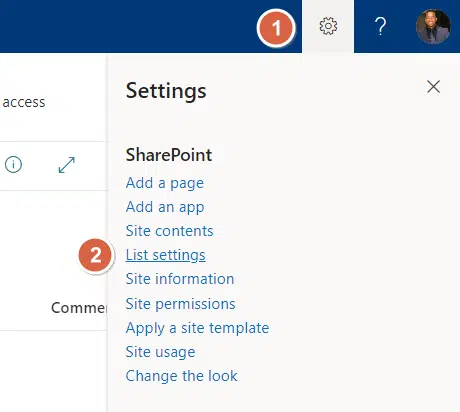
From the next page, focus your attention on permissions and management settings.
Click enterprise metadata and keyword settings:

The next page is where you can enable enterprise keywords on the list or library.
Simply tick the checkbox for adding an enterprise keywords column to the list:
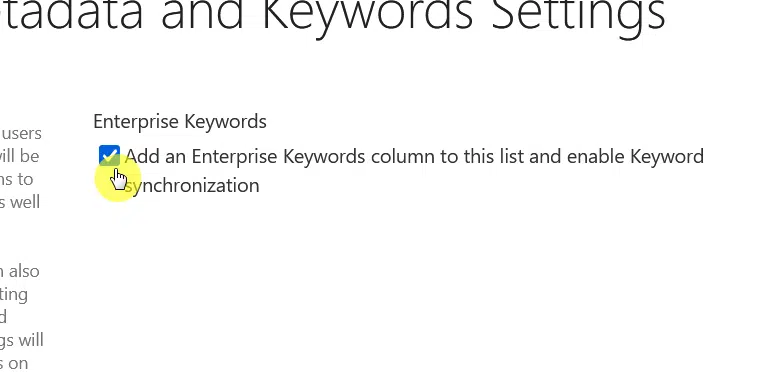
Don’t forget to click the OK button.
Part 2: Add the enterprise keywords
Because of your actions earlier, the enterprise keywords column is now available in the list or document library.
However, it’s possible that it might be hidden from view.
To show it:
- Click the add column button
- Hit the show or hide columns button
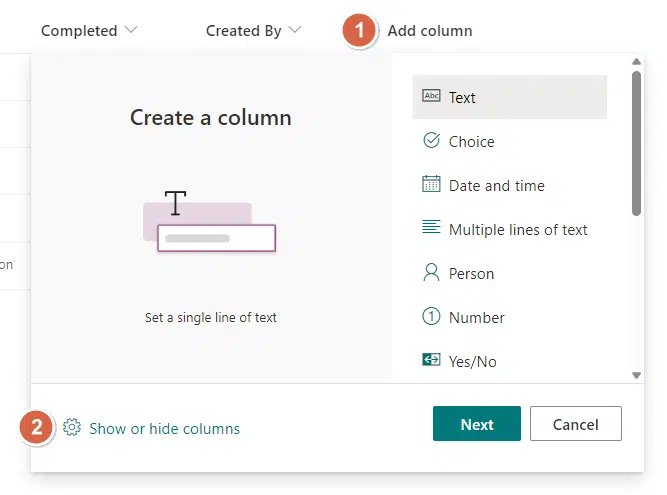
From there:
- Tick the box for enterprise keywords
- Change the ordering (if you want)
- Click the apply button
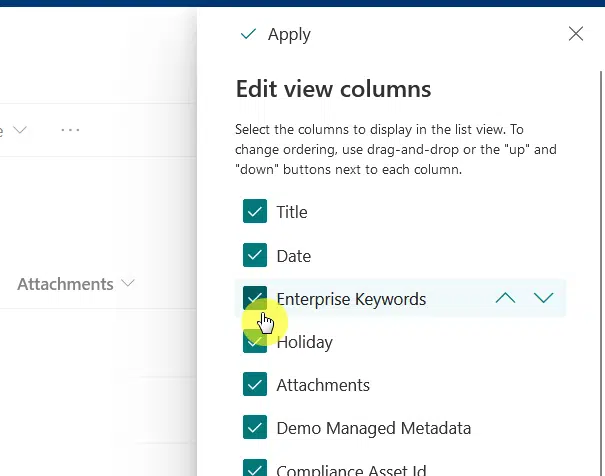
Now, the enterprise keywords column is a multi-value column and allows users to enter enterprise keywords in two ways:
- Shows the users suggestions from taxonomy
- Users can enter any word or phrase
Related: SharePoint Taxonomy Guide: How to Configure and Design
For example, enter the first few characters of the keyword into the field.
Then, select your option from the suggestions:
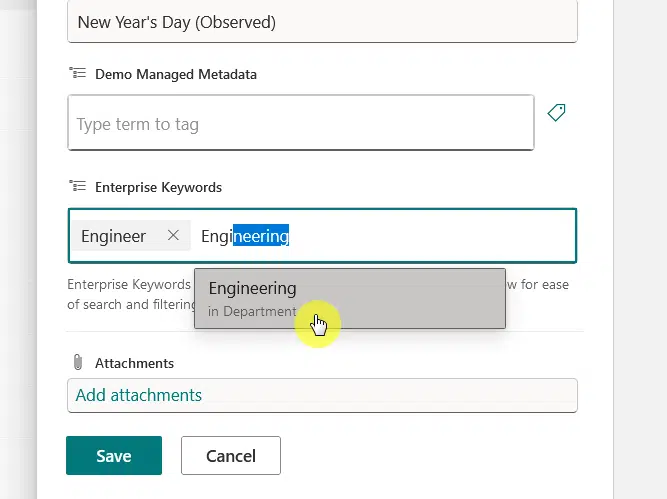
Note: Again, you can also enter your own custom keyword or phrase. When you hit enter, the field will accept whatever you entered.
After clicking the save button, the enterprise keyword or keywords you selected will now reflect in the list.
So how do you manage the keywords that your users entered in the enterprise keywords column?
Effectively managing enterprise keywords is crucial for maintaining an organized, user-friendly SharePoint environment.
The key here is to access the term store management tool — which you can do from SharePoint admin or site level.
Step 1: Access the term store management tool
For the site:
- Go to your site’s home page
- Click the gear icon
- Go to site information > site settings

You can then find term store management under site administration.
If on SharePoint admin center:
- Click the app drawer
- Hit the admin button
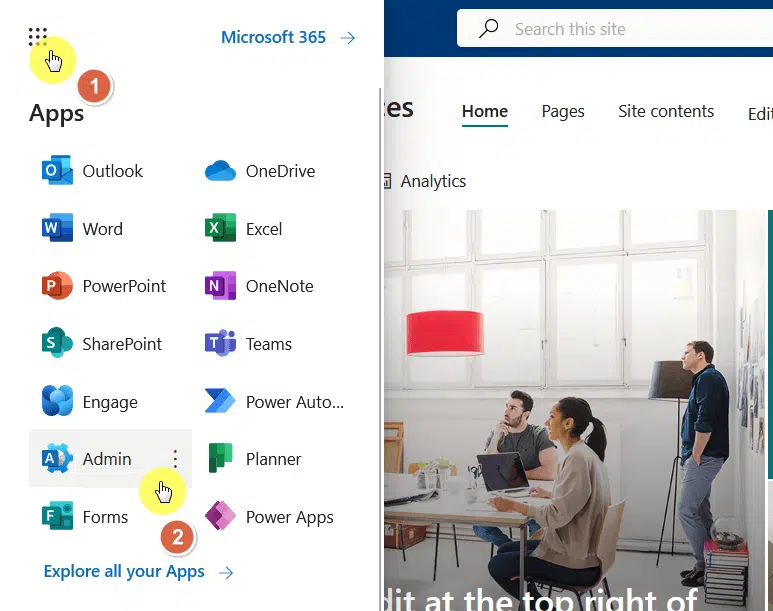
From the Microsoft 365 admin center:
- Expand (show all) the list of admin centers
- Select the SharePoint option

The term store management is under content services.
Step 2: Go to the keywords set
Let’s say I entered my own enterprise keyword (Holiday) on a list.
Where will it appear?
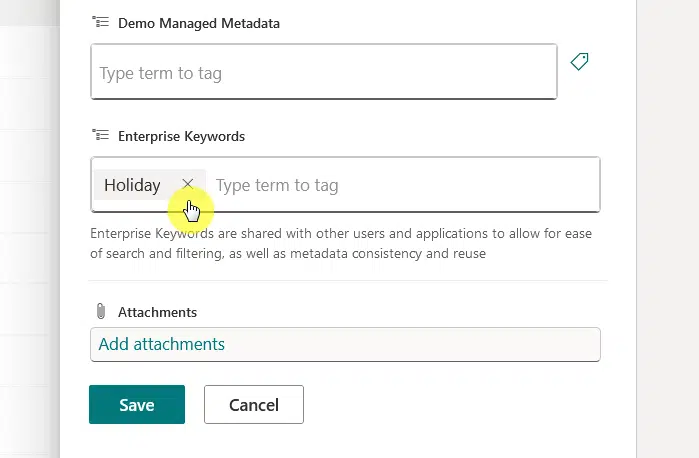
The answer is, you will find it under global term groups > system > keywords.
Here’s an example:
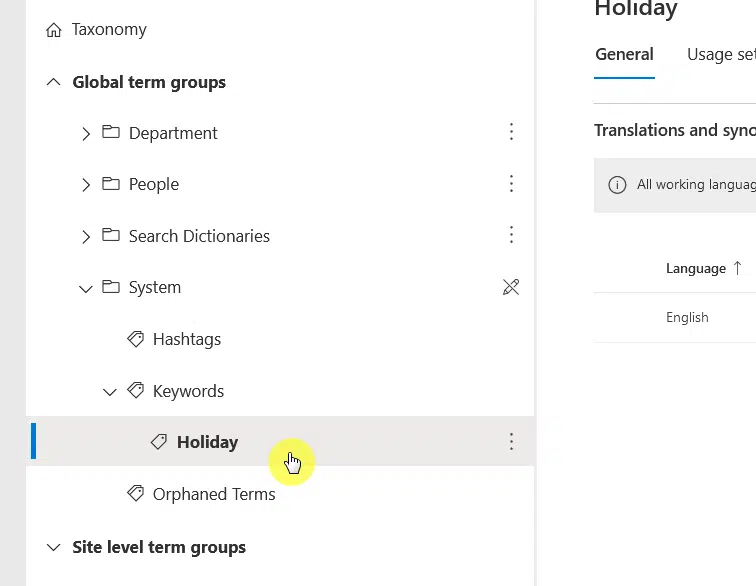
Step 3: Review existing keywords
From here, browse through the keywords in the set.
Keep an eye out for any redundant keywords, typos, or outdated terms.
If you find one, you can always delete it:
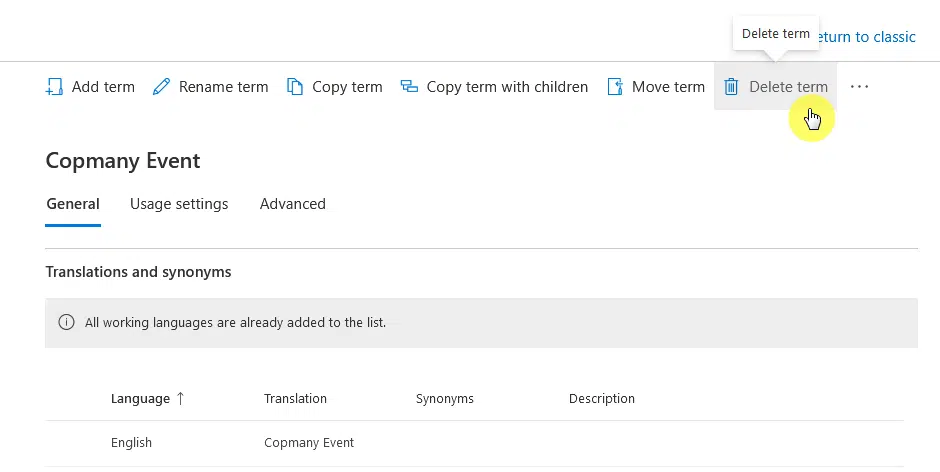
Besides deleting, you can also do the following:
- Add new keywords (when necessary)
- Edit existing keywords (like with typos)
- Merge keywords (to maintain consistency)
What’s important here, especially when adding new keywords, is to make sure that you added them in the right (keywords) set.
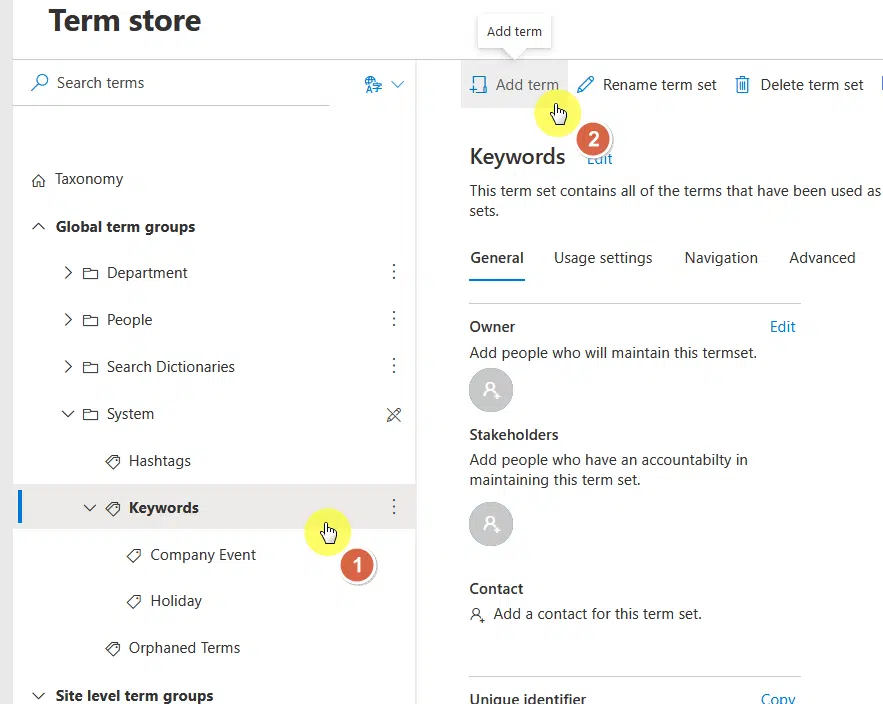
Related: SharePoint Taxonomy Guide: How to Configure and Design
Potential Challenges and Limitations in Their Usage
Enterprise keywords offer significant advantages in content classification and discovery within SharePoint.
However, the same with everything, with these benefits come potential challenges and limitations.
| Challenges/Limitations | Explanation | Mitigation/Fix |
| Inconsistent Usage | Different users might use varying terms for the same concept, leading to fragmented categorization. | Implement guidelines on keyword usage and provide examples. Regularly review keywords for consistency. |
| Maintenance Overhead | As more keywords are added, managing them becomes cumbersome. | Schedule periodic reviews and clean-ups of the keyword list. Employ tools to streamline management. |
| Relevance Issues | Outdated keywords can clutter search results and impede content discovery. | Monitor keyword relevance and phase out or update outdated terms. |
| Training and User Adoption | Without proper understanding, users might not utilize the feature effectively. | Offer training sessions, share best practices, and encourage feedback. |
| Scalability Concerns | Rapid growth in keywords can strain the system, potentially affecting performance. | Monitor system performance and consider implementing a keyword cap or using advanced management tools. |
| Potential for Duplication | Users might inadvertently create multiple similar keywords, leading to redundancy. | Use automated tools to detect and highlight potential duplicates. Merge or delete as necessary. |
| Limitation on Personalization | Enterprise keywords might not cater to personal or department-specific nuances. | Allow a mix of both enterprise keywords and user-specific tags for a more balanced approach. |
| Integration Challenges | Keywords need to work seamlessly with other SharePoint features. | Test integrations regularly and ensure that updates to SharePoint don’t disrupt keyword functionality. |
| Visibility and Privacy Concerns | Being always public, there’s a risk of exposing sensitive information. | Train users on what constitutes sensitive information and discourage or restrict its use in keywords. |
| Over-reliance on Keywords | Users might neglect other essential metadata or categorization methods. | Educate users on the importance of a balanced content management strategy, incorporating other methods. |
Difference Between Tags and Enterprise Keywords
In the SharePoint universe, both tags and enterprise keywords play essential roles in organizing and classifying content.
However, they serve distinct purposes and have unique characteristics.
Here’s a table that clearly differentiates their differences:
| Aspect | Tags | Enterprise Keywords |
| Definition and Purpose | User-generated words/phrases for content classification based on user perspectives | Keywords designed for organization-wide use to ensure content consistency |
| Scope and Usage | More flexible, can be specific to personal views, departments, or teams | Broad scope, used consistently across the organization |
| Management and Control | Users have more freedom; less centralized control | Managed centrally in the term store, offering better oversight |
| Integration with Term Store | Not always integrated unless specifically added | Directly integrated; any new keyword gets stored for future use |
| Visibility and Sharing | Can be private (user-specific) or public | Always public, shared across the SharePoint environment |
Definition and Purpose
Tags:
- These are user-generated words or phrases that can be assigned to content, often used in social tagging.
- They help in classifying information based on user perspectives and can be personal or public.
Enterprise Keywords:
- These are a specific type of keyword, part of a non-hierarchical term set known as the “keywords set.”
- They’re intended for use across the entire enterprise, ensuring consistency in content classification.
Scope and Usage
Tags:
- Typically, tags are more flexible and can vary widely among users.
- They can be specific to one’s personal views, departments, or teams.
- As they are more subjective, the tagging might not always be consistent across the organization.
Enterprise Keywords:
- These keywords have a broader scope, designed for organization-wide use.
- They provide a consistent approach to content classification across various sites and libraries in SharePoint.
Management and Control
Tags:
- Users have more freedom when it comes to creating and using tags.
- There’s less centralized control, allowing for more organic growth of terms.
Enterprise Keywords:
- They are managed centrally in the term store management tool, offering better oversight.
- Administrators can control which keywords are available, ensuring relevancy and avoiding redundancy.
Integration with Term Store
Tags:
- Not all tags are integrated with the SharePoint Term Store unless they’re specifically added to it.
Enterprise Keywords:
- They are directly integrated with the term store, and any new keyword added by users can be stored in the Enterprise Keywords term set, making it available for future use by others.
Visibility and Sharing
Tags:
- Depending on how they’re used, tags can be private (visible only to the person who added them) or public (visible to everyone).
Enterprise Keywords:
- These are always public and shared across the SharePoint environment, promoting uniformity in content tagging.
Best Practices in Using Enterprise Keywords
Utilizing enterprise keywords efficiently in SharePoint requires adherence to certain best practices.
Here are three things I suggest:
1. Consistent and Relevant Keyword Usage
The power of enterprise keywords lies in their consistent application.
When users across an organization use the same keywords for similar content, it enhances content discoverability and reduces redundancy.
Moreover, ensuring that the keywords used are relevant to the content they’re tagging is vital.
Irrelevant keywords can confuse users and make searches less efficient.
What to do:
- Establish clear guidelines on keyword usage and provide users with examples.
- Encourage teams and departments to communicate and agree on specific terms for recurring topics or projects.
- Periodically review and refine the list of keywords to ensure they remain relevant to the organization’s evolving needs.
2. Regularly Review and Optimize Keyword Lists
Over time, as more content gets added and the organization evolves:
The list of enterprise keywords can become cluttered with outdated or rarely-used terms.
Regularly reviewing and optimizing the list ensures that it remains streamlined and effective.
What to do:
- Schedule periodic reviews of the enterprise keywords list.
- During these reviews, phase out obsolete terms, merge similar keywords and add new ones that have become relevant.
- Engage with users to gather feedback on which keywords they find most (or least) useful.
3. Balance Between Centralized Control and User Flexibility
While enterprise keywords aim to provide a unified approach to content classification, it’s also essential to allow users some flexibility.
Too much centralized control can stifle users’ ability to tag content in ways that make sense to them.
On the other hand, too much flexibility can lead to a chaotic system.
What to do:
- Allow users the freedom to add new keywords when they feel existing ones don’t capture the essence of their content.
- However, implement a review process where these new keywords are periodically vetted for relevance, redundancy, and appropriateness.
This approach maintains a balance between consistency and flexibility.
Do you have any questions on SharePoint enterprise keywords or how to effectively utilize them? If yes, comment them down.
For any SharePoint-related questions/messages, send your query through the contact form here. I will reply asap.

